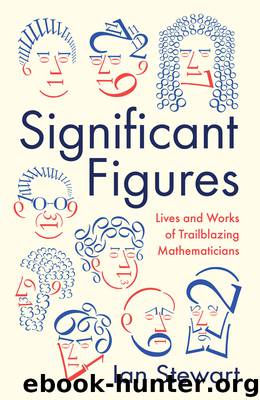Significant Figures by Stewart Ian;

Author:Stewart, Ian;
Language: eng
Format: epub
Publisher: Profile Books
15
Musician of the Primes
Bernhard Riemann
Georg Friedrich Bernhard Riemann
Born: Breselenz, Kingdom of Hanover, 17 September 1826
Died: Selasca, Italy, 20 July 1866
BERNHARD RIEMANN HAD SHOWN immense mathematical talent, technical mastery, and originality from the age of 20. Moritz Stern, one of his tutors, later said that ‘he already sang like a canary’. His other tutor, Gauss, seemed less impressed, but the courses Gauss was teaching were elementary, unlikely to showcase the student’s true abilities. Soon, even Gauss understood that Riemann was unusually able, and supervised his doctoral thesis. The topic was dear to Gauss’s heart: complex analysis. Gauss commented on the ‘gloriously fertile originality’ of the work and arranged an entry-level position for Riemann at Göttingen University.
In Germany, the next step after the PhD was Habilitation, a more advanced degree requiring deeper research that opened up a proper academic career by entitling its holder to become a Privatdozent, able to give lectures and charge fees. Riemann had spent two and a half years making big strides in the theory of Fourier series (Chapter 9). The research had gone well, but now he was beginning to think he’d bitten off more than he could chew.
The problem wasn’t the work on Fourier series. That was done and dusted, and Riemann was confident of its quality and accuracy. No, the problem was the final step in qualifying for Habilitation. The candidate had to deliver a public lecture. He had proposed three topics: two on the mathematical physics of electricity, a subject he had also studied under Wilhelm Weber, and, more daringly, one on the foundations of geometry, where he had some interesting but rather half-baked ideas. The choice from these three topics was up to Gauss, who at that time was working with Weber and deeply interested in electricity. What Riemann didn’t take into account was that Gauss was also deeply interested in geometry, and wanted to hear what Riemann had to say about it.
So now Riemann was working his socks off trying to develop his vague ideas about geometry into something that would make a real impression on the greatest mathematician of the age, in an area that luminary had been thinking about for much of his life. His starting point was a result of which Gauss was especially proud, his Theorema Egregium (page 109). This specifies the shape of a surface without reference to any surrounding space, and it inaugurated the subject of differential geometry. It led Gauss to study geodesics – shortest paths between points – and curvature, which quantifies how much the surface bends compared to the ordinary Euclidean plane.
Riemann planned to generalise Gauss’s entire theory in a radical direction: spaces of any dimension. Mathematicians and physicists were just beginning to appreciate the power and clarity of geometric thinking in ‘spaces’ with more than the usual two or three dimensions. Underlying this counterfactual viewpoint was something entirely sensible, the mathematics of equations in many variables. The variables play the role of coordinates, so the more variables there are, the greater is the dimension of this conceptual space.
Download
This site does not store any files on its server. We only index and link to content provided by other sites. Please contact the content providers to delete copyright contents if any and email us, we'll remove relevant links or contents immediately.
Modelling of Convective Heat and Mass Transfer in Rotating Flows by Igor V. Shevchuk(6225)
Weapons of Math Destruction by Cathy O'Neil(5832)
Factfulness: Ten Reasons We're Wrong About the World – and Why Things Are Better Than You Think by Hans Rosling(4487)
Descartes' Error by Antonio Damasio(3166)
A Mind For Numbers: How to Excel at Math and Science (Even If You Flunked Algebra) by Barbara Oakley(3103)
Factfulness_Ten Reasons We're Wrong About the World_and Why Things Are Better Than You Think by Hans Rosling(3046)
TCP IP by Todd Lammle(3013)
Applied Predictive Modeling by Max Kuhn & Kjell Johnson(2907)
Fooled by Randomness: The Hidden Role of Chance in Life and in the Markets by Nassim Nicholas Taleb(2861)
The Tyranny of Metrics by Jerry Z. Muller(2849)
The Book of Numbers by Peter Bentley(2779)
The Great Unknown by Marcus du Sautoy(2538)
Once Upon an Algorithm by Martin Erwig(2473)
Easy Algebra Step-by-Step by Sandra Luna McCune(2469)
Lady Luck by Kristen Ashley(2416)
Practical Guide To Principal Component Methods in R (Multivariate Analysis Book 2) by Alboukadel Kassambara(2380)
Police Exams Prep 2018-2019 by Kaplan Test Prep(2358)
All Things Reconsidered by Bill Thompson III(2261)
Linear Time-Invariant Systems, Behaviors and Modules by Ulrich Oberst & Martin Scheicher & Ingrid Scheicher(2233)
